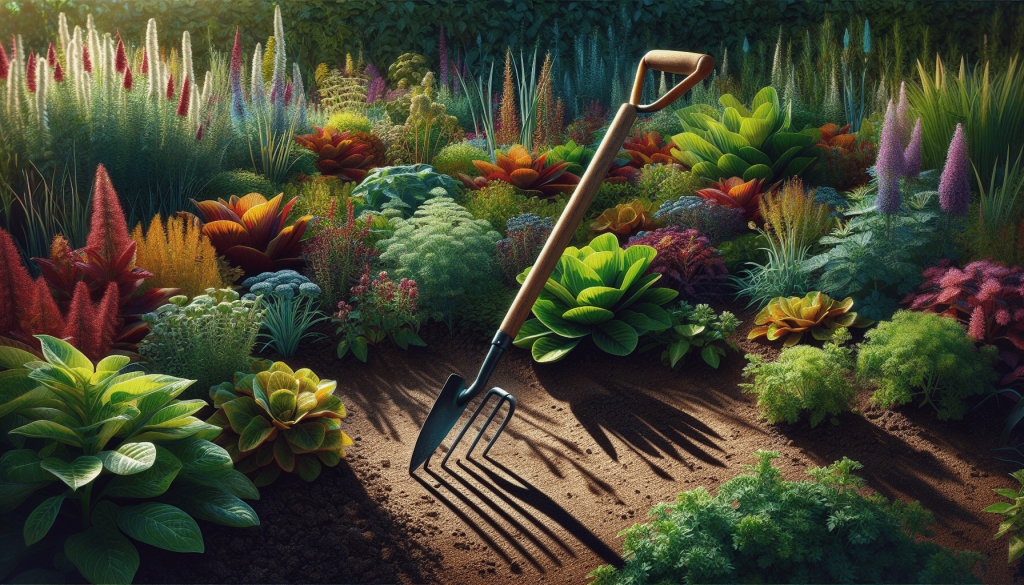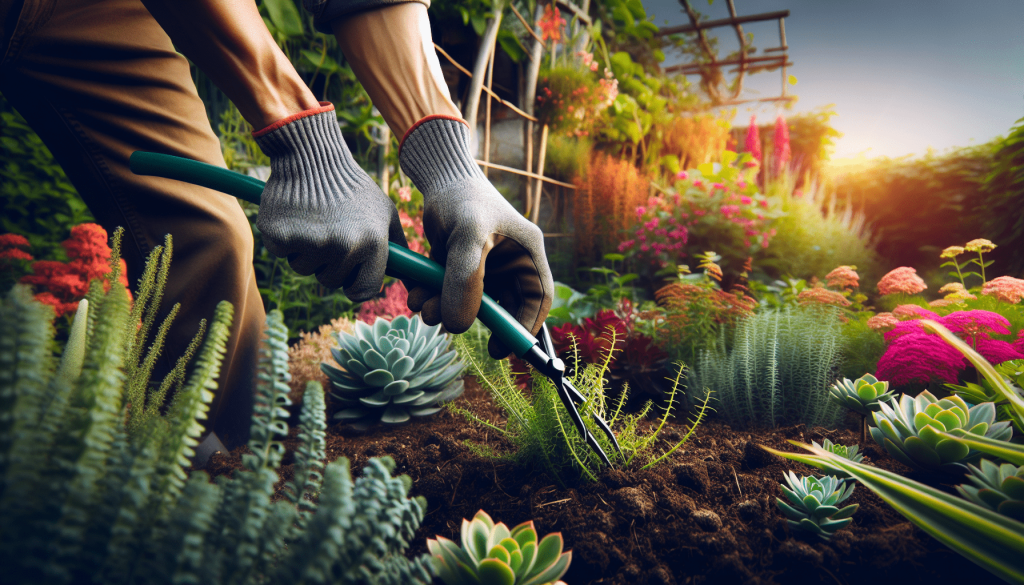Are you tired of battling with stubborn garden weeds? Look no further, as this article will provide you with valuable insights on the best practices for preventing and managing these unwanted invaders. Whether you are an experienced gardener or just starting out, we all know the frustration of spending countless hours weeding, only to have them reappear in no time. Discover the most effective methods and techniques to keep your garden weed-free and enjoy a thriving, beautiful outdoor space all year round.
Table of Contents
ToggleChoosing the Right Plants
When it comes to preventing and managing garden weeds, choosing the right plants is a great place to start. Consider using native plants in your garden, as they are well-suited to the local climate and soil conditions. Native plants also tend to be more resistant to pests and diseases, reducing the need for chemical interventions. Additionally, native plants provide important habitat and food sources for local wildlife. By planting a variety of native species, you can create a vibrant and diverse garden that thrives with minimal intervention.
Another important factor to consider is planting density. By planting your garden densely, you can minimize the amount of open space available for weeds to establish themselves. A well-planned and densely planted garden creates a canopy that shades the soil, preventing weed seeds from germinating and taking root. This not only reduces weed growth but also helps to conserve water by reducing evaporation. So, when designing your garden, aim for a lush and dense planting scheme that makes it difficult for weeds to gain a foothold.
Ground covers are also an excellent tool in the fight against weeds. Utilizing low-growing plants that spread quickly and densely can provide effective weed suppression. Ground covers help to shade the soil, preventing weed germination and growth. They also compete with weeds for resources such as light, water, and nutrients. Some examples of effective ground covers include creeping thyme, ivy, and ajuga. Just be sure to select ground covers that are appropriate for your climate and growing conditions.
Preparing the Soil
Properly preparing the soil before planting is essential for successful weed management. Start by removing any existing weeds, either by hand or using a hoe or cultivator. Be sure to remove the entire root system to prevent regrowth. This initial weed removal is crucial, as it helps to reduce competition and allows your desired plants to thrive.
Next, loosen the soil to create a favorable environment for plant growth. Use a garden fork or tiller to break up compacted soil, improving drainage and aeration. This helps plant roots penetrate the soil more easily, ensuring optimal nutrient uptake and overall plant health. Additionally, loosening the soil can make it more difficult for new weed seeds to take root.
Adding organic matter such as compost or well-rotted manure to the soil is another important step in preparing your garden. Organic matter improves soil structure, fertility, and moisture-holding capacity. It also promotes beneficial soil organisms that help to break down organic matter, suppress diseases, and outcompete weeds. Incorporating organic matter into the soil before planting provides an ideal growing environment for your plants, making them less susceptible to weed competition.
Mulching
Mulching is a highly effective method for preventing and managing garden weeds. By applying a thick layer of mulch around your plants, you can create a barrier that inhibits weed growth. Mulch blocks sunlight from reaching the soil surface, preventing weed seeds from germinating. Additionally, mulch helps to conserve soil moisture, regulate soil temperature, and reduce the likelihood of soil erosion.
When choosing the right type of mulch for your garden, consider factors such as availability, cost, and the specific needs of your plants. Organic mulches, such as wood chips, straw, or compost, gradually break down over time, enriching the soil with organic matter. Inorganic mulches, such as plastic or landscape fabric, provide longer-lasting weed suppression but do not contribute to soil health. Ultimately, the choice between organic and inorganic mulch depends on your preferences and the specific requirements of your garden.
While applying mulch, be mindful to leave some space around the stems of your plants. This prevents excessive moisture buildup and reduces the risk of stem rot and other diseases. Avoid piling mulch directly against plant stems, as it can create a favorable environment for pests and pathogens. Instead, create a small space, known as a mulch-free collar, around the base of each plant to allow for proper air circulation.
Proper Watering
Watering your garden correctly is not only crucial for the health of your plants but also plays a role in weed management. Water deeply and infrequently to encourage deep root growth and drought tolerance in your plants. This helps them establish strong root systems, making them more competitive against weeds. Shallow, frequent watering, on the other hand, encourages shallow root growth in both plants and weeds, making the garden more prone to weed infestations.
Avoid overwatering your garden, as excess moisture can create a favorable environment for weed growth. Weeds often thrive in moist soil, so it’s essential to strike a balance between providing adequate water for your plants while preventing excessive moisture accumulation. A good way to determine when to water is to check the soil moisture level by sticking your finger an inch or two into the soil. If it feels dry at that depth, it’s time to water.
Using drip irrigation or soaker hoses is an efficient way to deliver water directly to the root zones of your plants. This method minimizes water loss through evaporation and ensures that the water reaches the plant roots where it’s needed the most. By avoiding overhead watering, you can also reduce moisture on the surface of the soil, which can encourage weed seed germination.
Regular Maintenance
Regular maintenance is essential for keeping your garden healthy and weed-free. It’s important to monitor your garden regularly, paying close attention to any signs of weed growth. Catching weeds early allows for easier removal and prevents them from going to seed and spreading throughout your garden. Take the time to inspect your garden on a regular basis, either by walking through it or by examining plants up close. By staying vigilant, you can stay on top of weed growth and take action before it becomes a larger problem.
When you do spot weeds, remove them promptly. Hand weeding is often the most effective and environmentally friendly method. Wear protective gloves to protect your hands and pull weeds from the root, ensuring that you remove the entire plant. Dispose of weeds properly to prevent them from re-establishing in your garden or spreading to other areas. Avoid composting weed plants that have gone to seed, as this can result in the spread of weed seeds when the compost is used.
Another aspect of regular maintenance is proper pruning. Regularly pruning your plants not only helps to maintain their shape and size but also improves air circulation and light penetration. This reduces the likelihood of fungal diseases, which can weaken plants and make them more susceptible to weed competition. Pruning also allows for the removal of any dead or diseased plant material that could provide a food source or harbor pests.
Hand Weeding
Hand weeding is a tried-and-true method for tackling weeds in your garden. When hand weeding, it’s important to wear protective gloves to avoid injury and to prevent the transfer of weed seeds and plant pathogens. Select gloves that fit well and provide a good grip to ensure effective weed removal.
To effectively remove weeds by hand, grasp the weed as close to the base as possible, near the soil surface. Firmly apply pressure and pull the weed gently but firmly, making sure to remove the entire root system. If the soil is dry, moistening it slightly before weeding can make it easier to remove weeds without breaking the root system.
After removing weeds, dispose of them properly. If the weeds have not yet gone to seed, you can compost them as long as your compost reaches high enough temperatures to kill any weed seeds. Alternatively, you can bag them up and dispose of them in your regular trash to prevent the spread of weed seeds.
Chemical Weed Control
While chemical weed control should be a last resort, there are situations where it may be necessary. When using herbicides, it’s essential to choose selective herbicides that target the specific weed species you are trying to control while minimizing harm to desirable plants. Read and follow the label instructions carefully to ensure safe and effective use. Protective gear such as gloves, goggles, and a mask should be used when applying herbicides to minimize exposure.
Chemical weed control should be used sparingly and only when other methods have proven ineffective. It’s important to consider the potential impacts on the environment, including water sources, wildlife, and beneficial insects. Whenever possible, explore alternative weed control methods before resorting to chemical interventions.
Natural Weed Control Methods
If you prefer to avoid chemical weed control methods, there are several natural alternatives available. Vinegar and boiling water can be effective in killing small weeds. Simply apply vinegar directly to the weed or pour boiling water over it, making sure to avoid contact with desirable plants. Keep in mind that these methods are non-selective, meaning they can harm any plant they come into contact with. Exercise caution and apply them carefully to avoid damaging your garden.
Corn gluten meal is another natural weed control method. It is a natural byproduct of corn processing and acts as a pre-emergent herbicide, preventing weed seeds from germinating. Apply corn gluten meal to your garden in early spring before weed seeds begin to germinate. Water it in well to activate its weed-suppressing properties. While corn gluten meal can be effective, it’s important to note that it may not be suitable for all garden situations, so be sure to research and understand its limitations before use.
Homemade weed sprays can also be used as a natural weed control method. These sprays often utilize natural ingredients such as vinegar, salt, dish soap, or citrus oil to kill weeds. While homemade weed sprays can be effective on small, young weeds, they may not be as reliable on larger, established weeds. It’s important to note that homemade weed sprays are non-selective and can harm desirable plants, so apply them carefully and avoid contact with your garden plants.
Crop Rotation
Practicing crop rotation in your garden can help prevent weeds from becoming established and improve overall soil health. By rotating the types of plants you grow each year, you can disrupt the life cycles of weeds and reduce their impact. Different crops have different nutrient requirements and can create imbalances in the soil, making it less favorable for certain weed species. Additionally, rotating crops can help break the cycle of pests and diseases that may be specific to certain plants.
When planning your crop rotation, consider grouping plants based on their botanical families. Avoid planting crops from the same family in the same location year after year. Aim to have a minimum of three years between planting the same crop or a crop from the same family in the same area of your garden. This will help minimize the buildup of pests and diseases and reduce weed pressure.
Crop rotation is also beneficial for soil health. Different plants have different root structures and nutrient requirements, which can help improve soil structure and fertility over time. Deep-rooted crops help break up compacted soil, improve drainage, and bring nutrients up from deeper layers. Leguminous plants, such as beans and peas, have the ability to fix nitrogen in the soil, enriching it for future crops. By diversifying your plantings and practicing crop rotation, you can create a healthier garden ecosystem that is less susceptible to weed infestations.
Preventive Measures
Taking preventive measures in your garden can go a long way in reducing weed problems. One important step is to avoid spreading weed seeds. After weeding your garden or any other area with weeds, be cautious not to transport the weed seeds to other parts of your garden. Clean your shoes and tools thoroughly to prevent unintentional spread. It’s also a good idea to wash off any weed seeds that may be stuck to the bottom of your shoes or garden tools before moving to another garden or yard.
Cleaning your garden tools and equipment regularly is another preventive measure. Weed seeds can easily hitch a ride on your tools and be inadvertently spread throughout your garden. After each use, take a few minutes to clean off any soil or plant debris from your tools. If you notice any weed seeds, remove or wash them away. By keeping your tools clean, you can significantly reduce the risk of introducing new weed seeds into your garden.
Lastly, avoid overfeeding your plants. Overly fertile or overfed plants tend to produce lush growth, which can attract pests and create a favorable environment for weeds. Instead, apply fertilizer judiciously, following the recommendations for the specific plants you are growing. Providing adequate but not excessive nutrition to your plants helps to strike a balance that promotes optimal growth while reducing the likelihood of weed competition.
In conclusion, preventing and managing garden weeds requires a comprehensive approach that includes careful plant selection, soil preparation, mulching, proper watering, regular maintenance, and effective weed control methods. By following these best practices and staying proactive, you can create a beautiful and weed-free garden that thrives with minimal effort. Remember to stay vigilant, practice good cultivation techniques, and choose the most appropriate methods for your unique garden situation. With time and consistency, you can achieve weed-free success and enjoy the beauty and productivity of your garden.








